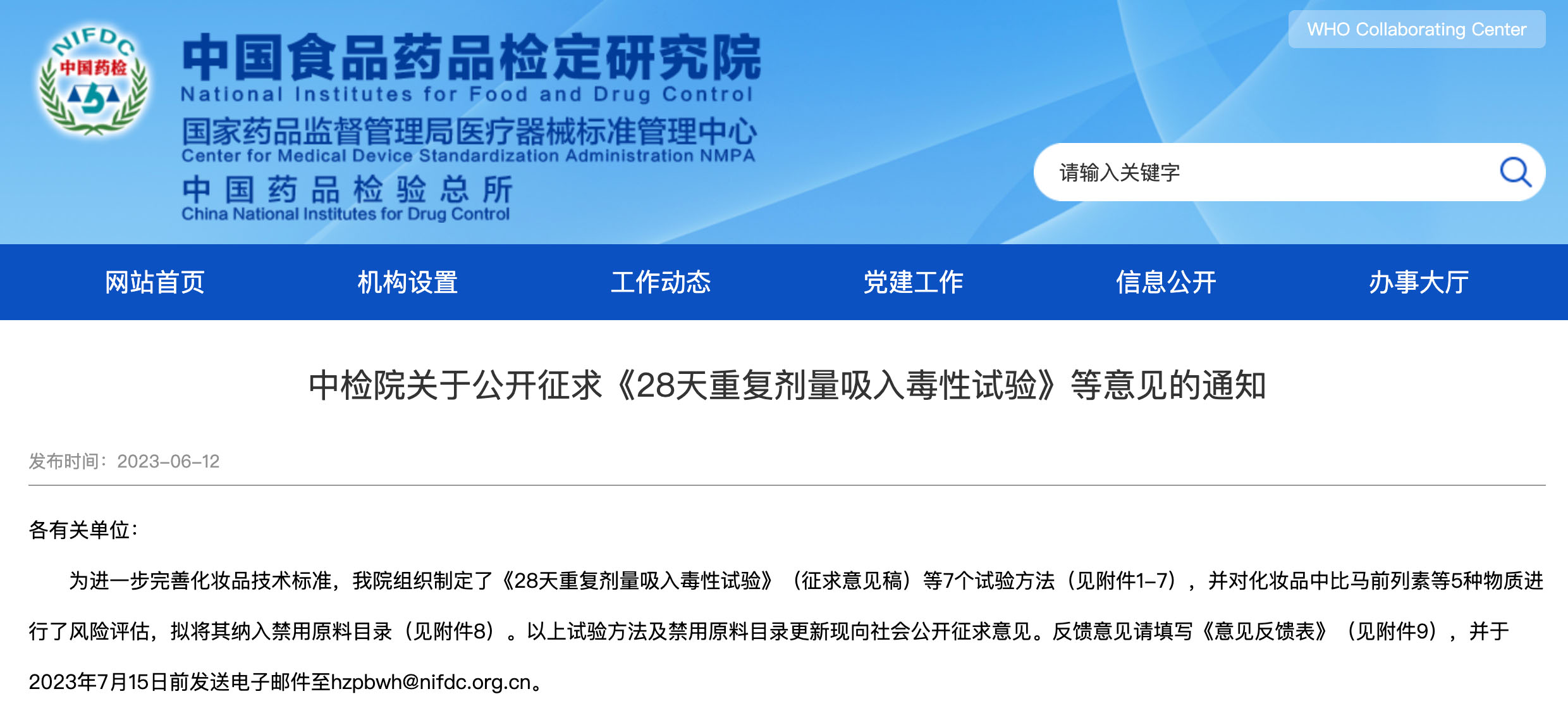Enterprise attention! The CCDI will update the list of prohibited ingredients for cosmetics and introduce more alternative testing methods for cosmetics
In order to further improve the technical standards for cosmetics, the China Institute of Food and Drug Control (hereinafter referred to as the "CCDI") issued a notice on the public soliciting opinions on the 28-day Repeated Dose Inhalation Toxicity Test, involving 7 test methods, and the update of the prohibited raw material list.
In order to further improve the technical standards of cosmetics, China National Institute of Food and Drug Control (hereinafter referred to as “ China People's Procuratorate ”) Issued a notice on the public solicitation of opinions on the "28-day Repeated Dose Inhalation Toxicity Test", involving 7 test methods, and the update of the prohibited raw material list.

● Supplemental List of Prohibited Ingredients for Cosmetics
● The following attachments can be obtained by clicking the original: Notice of CCDI on Soliciting opinions on "28-Day Repeated Dose Inhalation Toxicity Test"
1. 28-Day Repeated Dose Inhalation Toxicity Test (Draft for Comment) and Drafting Instructions
Range:
This code specifies the basic principles, requirements and methods of 28-day repeated dose inhalation toxicity tests for rodents.
This specification is applicable to the evaluation of 28-day repeated dose inhalation toxicity of cosmetic raw materials.
Test purpose:
For cosmetic raw materials with potential for short-term repeated inhalation exposure, a 28-day repeated dose inhalation toxicity test is required. Through this test, not only the health effects caused by repeated inhalation of the subject matter in a certain period of time, the target organs of the subject matter and the accumulation capacity of the subject matter can be obtained, but also the level of no harmful effects of inhalation can be estimated, and the latter can be used for quantitative risk assessment of population inhalation.
2. 90-Day Repeated Dose Inhalation Toxicity Test (Draft for Comment) and Drafting Instructions
Range:
This specification specifies the basic principles, requirements and methods for 90-day repeated dose inhalation toxicity tests in rodents.
This specification is applicable to the evaluation of 90-day repeated dose inhalation toxicity of cosmetic raw materials.
Test purpose:
For cosmetic raw materials with potential for long-term repeated inhalation exposure, repeat dose inhalation toxicity test for 90 days is required. Through this test, not only the health effects caused by repeated inhalation of the subject matter in a certain period of time, the target organs of the subject matter and the accumulation capacity of the subject matter can be obtained, but also the level of no harmful effects of inhalation can be estimated, and the latter can be used for quantitative risk assessment of population inhalation.
3. "Extended Generation Reproductive Development Toxicity Test (Draft for Comments) and Drafting Instructions"
Range:
This specification specifies the basic principles, test methods and technical requirements of extended generation reproductive development toxicity tests.
This specification is used to detect the reproductive and developmental toxicity of cosmetic raw materials.
Test purpose:
To provide accurate information about the effects of prenatal and postnatal exposure on reproductive function, fertility and offspring development of female and male animals.
4. "Two-Generation Reproductive Development Toxicity Test (Draft for Comments) and Drafting Instructions"
Range:
This code specifies the basic principles, test methods and technical requirements of two-generation reproductive development toxicity tests.
This specification is used to detect the reproductive and developmental toxicity of cosmetic raw materials.
Test purpose:
To provide accurate information about the effects of prenatal and postnatal exposure on reproductive function, fertility and offspring development of female and male animals.
5. "Skin Absorption in vivo test Methods (Draft for Comments) and Drafting Instructions"
Range:
This method specifies terms and definitions, test principles, test methods, test data, and reports of in vivo test methods for skin absorption.
This method is suitable for in vivo test of transdermal absorption of cosmetic raw materials.
Test purpose:
This method describes the in vivo test method of transdermal absorption of cosmetic raw materials, so as to provide test basis for toxicity classification, labeling and application of cosmetic raw materials. This test method is applicable to single-component cosmetic raw materials. If non-single-component raw materials are evaluated by this method, more scientific evidence needs to be provided to illustrate its feasibility.
6. "Acute Toxicity Classification Method for Acute Inhalation Toxicity Test (Draft for Comments) and Drafting Instructions"
Range:
This test method specifies the test principle, test method, data and report of acute toxicity classification method for acute inhalation toxicity test.
This test method is suitable for acute toxicity classification of acute inhalation toxicity of cosmetic raw materials.
Test purpose:
The purpose of this test method is to obtain the health hazard information and other data of the tested object through testing. the United Nations (UN) Globally Harmonized System (GHS) of Classification and Labelling of Chemicals Chemicals) Classification criteria for acute inhalation toxicity classification of chemicals for acute toxicity. This test method is applicable to single-component cosmetic raw materials. If non-single-component raw materials are evaluated by this method, more scientific evidence needs to be provided to illustrate its feasibility. This test method is not suitable for testing insoluble isomers, fibers, nano-materials, etc.
< /p> 7. "In Vitro Skin Allergy U937 Cell Activation Test (Draft) and Drafting Instructions"
Range:
This method specifies the basic principles, requirements and methods of U937 cell activation test for skin allergy in vitro.
This method is suitable for the evaluation of potential sensitization of chemical raw materials used in cosmetics.
Test purpose:
This test was used to detect the expression of CD86, a surface marker of human histiocytic lymphoma cells cultured in vitro, to evaluate the possibility of skin allergy caused by the subject.
8. Supplement List of Prohibited Raw Materials for Cosmetics
9. Feedback Form





 Consultation
Consultation
 400-115-9001
400-115-9001